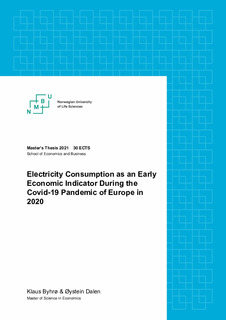| dc.description.abstract | The Covid-19 pandemic, and consequent policy measures, is currently causing tremendous losses and costs to humanity, both socially and economically. This drastic and abrupt shock has been followed by policy measures to mitigate economic losses, for businesses and households. For governments and other economic agents, immediate and precise information on the severity of outcomes can be vital in responding properly to the situation. Traditional economic indicators are reported only after-the-fact, and the more urgent need to know creates an incentive to use more creative economic indicators. This thesis aims to examine whether electricity consumption data could have been used as a reliable early predictor of the economic downturn of ten European countries across the two first waves of the pandemic, in 2020. A method of comparing estimated impacts on electricity consumption and GDP is used to analyse this relationship. In estimating these impact measures, we model both daily electricity consumption and quarter-yearly GDP, and compare these with the actual observed levels. The results indicate a positive relationship in the six continental European countries, as expected, though varying in magnitude. The results of the four Scandinavian countries are more dubious, and a clear relationship one way or the other cannot be concluded. We also find that electricity consumption and economic activity impacts diverge towards the end of the year, with electricity consumption levels normalizing. A weakness of the analysis lies in its sole use of aggregate power load data and its generalized modelling. We suspect clearer results could be found in each case if analysed more specifically, and by separating electricity consumption of residential and productive sectors. | en_US |

